The drawings for March 8 are beautiful with their own hands. New workshops in the technique of "drawing and painting" on the theme "March 8
The long-awaited spring is coming, and with it our favorite holiday - March 8. This is International Women's Day. It is celebrated at the very beginning of spring, when there is still snow in some places, icicles are hanging and even there are frosts ... But the air is already blowing in the spring, the sun is shining and it is getting warmer in the soul. We congratulate our mothers, grandmothers, sisters, girlfriends, classmates. We give them flowers - the first, tender, spring ... also on this day it is customary to give gifts and, of course, greeting cards. Let's draw a drawing for March 8 in stages and include it in a self-made greeting card. This gift is so valuable that it is made by hand.
Stage 1. So, we draw the basis of our image. Two figures, similar to a circle, but not quite round, but rather, oval, we place on one straight line, passing obliquely a sheet of paper. A curved line departs from the lower oval, at the top of which we draw two small figures - one looks like an oval, the other looks like a leaf.

Stage 2. On two oval figures we begin to draw the curved lines of the future figure "8". They are curled, each of them looks like a steam room, but directed in the other direction.

Stage 3. Along the borders of the ovals, we make the edges of the number “8”. Slightly retreat from the original lines inside. The figure "8" should be depicted as if lying on the plane of the picture.

Stage 4. On the curve of the line drawn in stage 1 from the lower oval, we draw a spring flower - a tulip: a straight stalk, two acute-angled protruding leaves and the flower itself, consisting of closed petals.

Step 5. Now add more tulips. We draw their flowers just in those small figures from stage 1. These are buds. Stalks go down from them and leaves are also visible below.
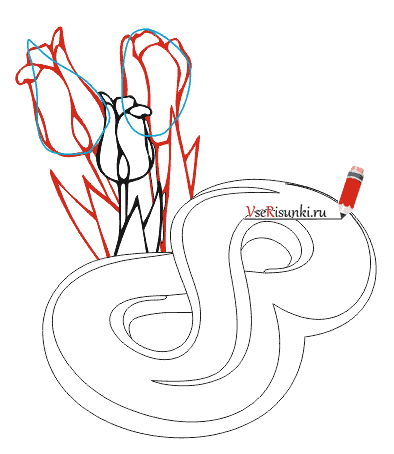
Stage 6. Along the edges of these three tulips we will draw two more flowers. They are smaller in size. It turned out a bouquet of five tulips, located behind the number "8".
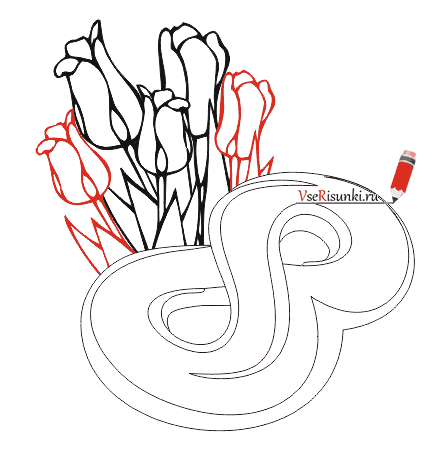
Step 7. At the very figure "8" we will make additional smooth curls of various configurations: patterns, dots, etc. This will then give some volume when coloring the figure.

Step 8. At the bottom, add an oval in which there will be an inscription. From above we will draw small butterflies.

For example: charcoal drawing, pencil drawing, ink and pen drawing ...
Painting - the type of fine art associated with the transfer of visual images through the application paints on a solid or flexible basis; digital imaging; as well as works of art made in such ways.
The most common are paintings made on flat or almost flat surfaces, such as canvas, wood, cardboard, paper, processed wall surfaces, etc., stretched on a stretcher. Also painted with images on decorative and ceremonial vessels whose surfaces may have a complex shape.
And remember, the so-called first “Kalya-Malya” of your baby can later become unsurpassed masterpieces of painting or drawing.
Description of the question
Soon the holiday of March 8, this day is considered an international women's day. Of course, not all people know the true and historical meaning of this holiday. It all began in the late 1880s, when the female gender began to seek equality with men, first in Europe and then around the world. After that, attitudes toward women changed, they began to be more respected and valued in society, their equality was recognized. It so happened that once the holding of such events by women coincided with the day off, it was March 8th. Therefore, they decided to legitimize this date and recognize it as a women's day. Of course, the legal and political side of this holiday has all been forgotten a long time ago, but they still continue to celebrate it, at the moment it has taken on the form simply as a day of increased attention and reverence for women. No holiday is complete without solemn replicas, congratulations and festive posters or postcards. Let's make our share in the women's holiday and decorate it nicely with posters, or draw a postcard. I will offer you two options for drawing colors by the Eighth of March, you can make both of them, or choose the one that suits you best.
Step by Step Solution I will begin, perhaps, first with a more complex option. You and I need to place our future bouquet of flowers on paper so that it is harmonious, so we will make its outlines with us, draw an oval, flowers will look out of this “oval”. Then we will draw to this oval like a “bottom”, agree that now it’s more true like a ladle, these will be the edges of our bouquet, but this is not all the work on the sketch of a bouquet wrapper. When you paint, try not to press on the pencil, so that your strokes could later overlap with paint, or rubbing with an eraser if you need it.
I will begin, perhaps, first with a more complex option. You and I need to place our future bouquet of flowers on paper so that it is harmonious, so we will make its outlines with us, draw an oval, flowers will look out of this “oval”. Then we will draw to this oval like a “bottom”, agree that now it’s more true like a ladle, these will be the edges of our bouquet, but this is not all the work on the sketch of a bouquet wrapper. When you paint, try not to press on the pencil, so that your strokes could later overlap with paint, or rubbing with an eraser if you need it.
 Now we schematically outline the flowers. No, we will not have four flowers in a bouquet, just mimosa and other very small flowers, we especially will not mark. Small, light, white flowers are better not to detail strongly with a pencil, since then we will have difficulties to score a pencil with paints.
Now we schematically outline the flowers. No, we will not have four flowers in a bouquet, just mimosa and other very small flowers, we especially will not mark. Small, light, white flowers are better not to detail strongly with a pencil, since then we will have difficulties to score a pencil with paints.
 Now we will start drawing the largest and most visible flowers, and these are exactly two daffodils and two tulips.
Now we will start drawing the largest and most visible flowers, and these are exactly two daffodils and two tulips.
 Here are the traced flowers, we have two sprigs of mimosa, two tulips, two daffodils and light, white, small flowers, looking out of the bouquet on the right side, so the number of flowers we will have is correct and congratulatory.
Here are the traced flowers, we have two sprigs of mimosa, two tulips, two daffodils and light, white, small flowers, looking out of the bouquet on the right side, so the number of flowers we will have is correct and congratulatory.
 Now we take the eraser and wipe the auxiliary lines of the pencil so that they do not spoil our poster or card later.
Now we take the eraser and wipe the auxiliary lines of the pencil so that they do not spoil our poster or card later.
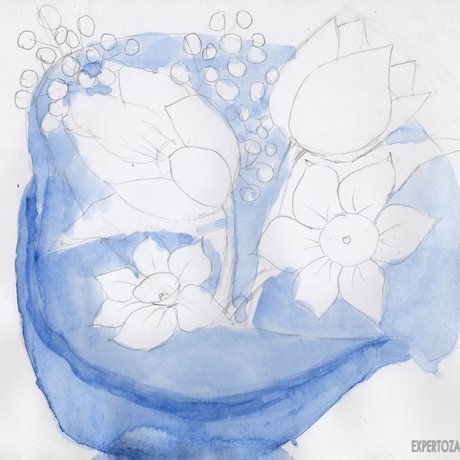 Decide on the color of the bouquet wrapper and apply it carefully, without touching the flowers. The paint should be diluted on the palette and not applied in a thick consistency. It is desirable that the wrapper is not red tones, as the tulips shown here, we will draw red.
Decide on the color of the bouquet wrapper and apply it carefully, without touching the flowers. The paint should be diluted on the palette and not applied in a thick consistency. It is desirable that the wrapper is not red tones, as the tulips shown here, we will draw red.
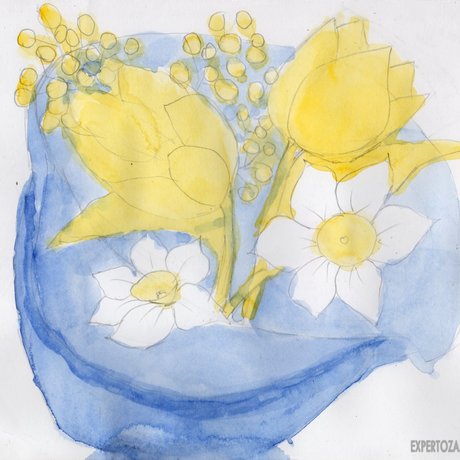 Wait for drying. When the bouquet wrapper has dried, take a yellow one and paint over the tulip heads and leaves. The leaves can be painted over with a salad color, as you wish, we still prepare the base anyway. No, we will not have yellow leaves, or lettuce, our tulips will not be yellow here, just this color is secondary and it is slightly in shades, this color is the base. We paint over the heads of tulips, as well as the middle in daffodils, color the mimosa and leave it to dry again.
Wait for drying. When the bouquet wrapper has dried, take a yellow one and paint over the tulip heads and leaves. The leaves can be painted over with a salad color, as you wish, we still prepare the base anyway. No, we will not have yellow leaves, or lettuce, our tulips will not be yellow here, just this color is secondary and it is slightly in shades, this color is the base. We paint over the heads of tulips, as well as the middle in daffodils, color the mimosa and leave it to dry again.
 When drying has come, we will take the scarlet color and begin to draw the petals of our tulip with a wide brush. Look very carefully at the image, pay special attention to the direction of the strokes on the petal of the tulip, which I began to paint, they go, as if in a slant in the middle of the petal, pushing away from each other.
When drying has come, we will take the scarlet color and begin to draw the petals of our tulip with a wide brush. Look very carefully at the image, pay special attention to the direction of the strokes on the petal of the tulip, which I began to paint, they go, as if in a slant in the middle of the petal, pushing away from each other.
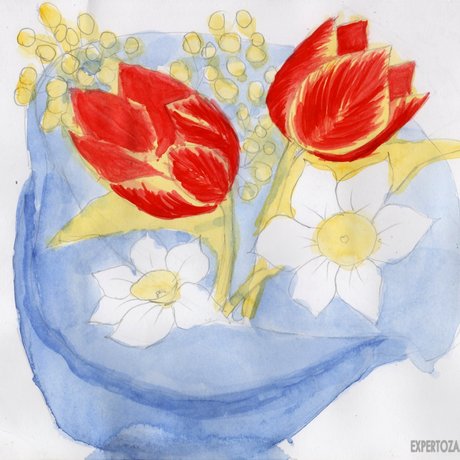 So, we finish the work with a scarlet color. When you paint over the inside of a tulip, just paint over it without this hatch, which I told you about in the previous step, this only concerns the surface part of the petal. Yellow color on the tulips should look out a little and gleam, especially at the edges. We are waiting for drying to continue to work.
So, we finish the work with a scarlet color. When you paint over the inside of a tulip, just paint over it without this hatch, which I told you about in the previous step, this only concerns the surface part of the petal. Yellow color on the tulips should look out a little and gleam, especially at the edges. We are waiting for drying to continue to work.
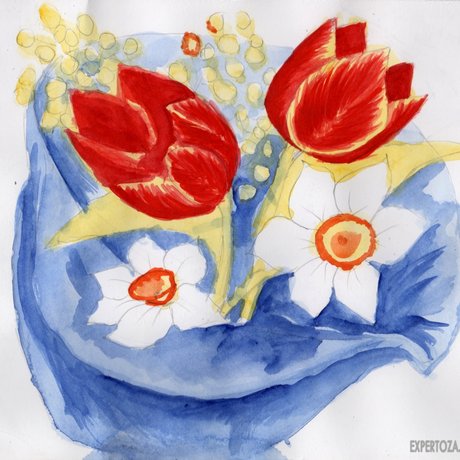 Take the color of pink kraplaka and scarlet on top, do about the same strokes, as we did before. Just do not be zealous and completely clog the scarlet color, it must be translucent, pink should be applied in places. Work on the middle of the daffodil, you will need a thin brush and orange color. We will also do a shading on the wrapper of our bouquet with a color slightly darker than the color with which we completely painted the bouquet.
Take the color of pink kraplaka and scarlet on top, do about the same strokes, as we did before. Just do not be zealous and completely clog the scarlet color, it must be translucent, pink should be applied in places. Work on the middle of the daffodil, you will need a thin brush and orange color. We will also do a shading on the wrapper of our bouquet with a color slightly darker than the color with which we completely painted the bouquet.
 We finish the shading of the bouquet wrapper. Let's work on the daffodils again, this time with petals. Dilute the pale blue color with water on the palette and shade it closer to the middle of the petal, this should be done on each petal of the narcissus.
We finish the shading of the bouquet wrapper. Let's work on the daffodils again, this time with petals. Dilute the pale blue color with water on the palette and shade it closer to the middle of the petal, this should be done on each petal of the narcissus.
 We now proceed to the mimosa, look at the left side of the picture, we will do the edges with small dots with mimosa, each of its “balls”. We work on the stem and leaves of our flowers, take a dark green, marsh color (glauconite, chromium oxide) and record them.
We now proceed to the mimosa, look at the left side of the picture, we will do the edges with small dots with mimosa, each of its “balls”. We work on the stem and leaves of our flowers, take a dark green, marsh color (glauconite, chromium oxide) and record them.
 Work on each “ball” of mimosa is completed, just look at the stems and leaves of flowers, as you see, with you it’s not a purely dark green color, but the intermediate yellow color is a little translucent, I hope you now understand why was used by me.
Work on each “ball” of mimosa is completed, just look at the stems and leaves of flowers, as you see, with you it’s not a purely dark green color, but the intermediate yellow color is a little translucent, I hope you now understand why was used by me.
 Let's draw a little greenery, we don’t need an intermediate color here, just make stalks of mimosa. Let's start adding small bright flowers on the right side of the bouquet, we will take a thin brush with blue color.
Let's draw a little greenery, we don’t need an intermediate color here, just make stalks of mimosa. Let's start adding small bright flowers on the right side of the bouquet, we will take a thin brush with blue color.
 At this stage of our work, we will give the postcard clarity and darken places where it seems to us are not enough shades. As you can see, on the right we have drawn the necessary number of small flowers (you can do more), now take the blue one and outline the daffodils for brightness. All of you have probably noticed many times that closer to the stalk, black color is clearly visible on the head of tulips, in order to give tulips more realism, I suggest that you do it. Dilute the black paint on the palette and carefully paint it, just do not overdo it with black, it should not look like a black spot on tulips. Who is afraid to spoil, it is better to abandon this idea, your tulips and so will look great. When the work is dry, it can already be considered finished.
At this stage of our work, we will give the postcard clarity and darken places where it seems to us are not enough shades. As you can see, on the right we have drawn the necessary number of small flowers (you can do more), now take the blue one and outline the daffodils for brightness. All of you have probably noticed many times that closer to the stalk, black color is clearly visible on the head of tulips, in order to give tulips more realism, I suggest that you do it. Dilute the black paint on the palette and carefully paint it, just do not overdo it with black, it should not look like a black spot on tulips. Who is afraid to spoil, it is better to abandon this idea, your tulips and so will look great. When the work is dry, it can already be considered finished.
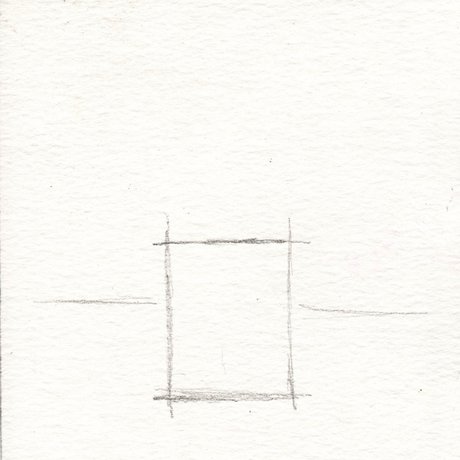 Now I will tell you a more simplified version of drawing a bouquet with flowers. I came up with these flowers myself, with flowers you can do everything that your imagination allows you to do. In this paper, watercolor is used for paper, but this is not a prerequisite; a simple thick drawing paper will do as well, we will not deal with multi-layered color and their mixing. So, draw a vase, schematically depict it as a rectangle.
Now I will tell you a more simplified version of drawing a bouquet with flowers. I came up with these flowers myself, with flowers you can do everything that your imagination allows you to do. In this paper, watercolor is used for paper, but this is not a prerequisite; a simple thick drawing paper will do as well, we will not deal with multi-layered color and their mixing. So, draw a vase, schematically depict it as a rectangle.
 We draw our vase in a rectangle, of course, you can come up with a vase of its shape.
We draw our vase in a rectangle, of course, you can come up with a vase of its shape.
 We draw three stalks and three small circles above them, these circles will be the middle in our colors.
We draw three stalks and three small circles above them, these circles will be the middle in our colors.
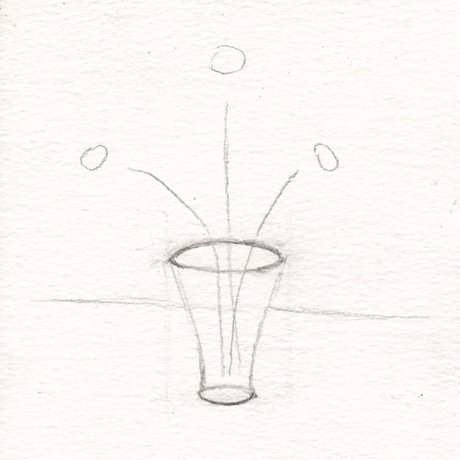 Erase the auxiliary lines with an eraser carefully. In general, the sketch is completed with a simple pencil, we will do the rest with colors.
Erase the auxiliary lines with an eraser carefully. In general, the sketch is completed with a simple pencil, we will do the rest with colors.
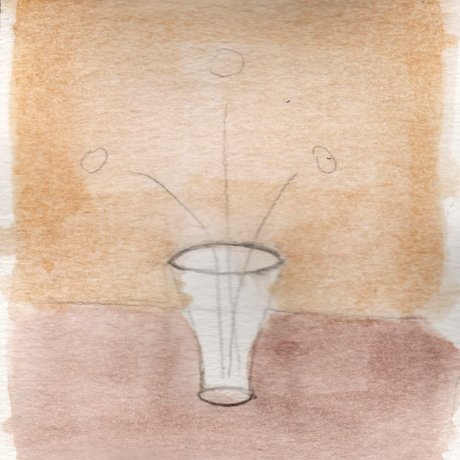 Select the color of the table on which the vase and the background color (wallpaper) will stand. I chose sand (ocher) for the background and brown for the table. First we painted the top, the background was sandy, then the table was brown, now we are waiting for drying.
Select the color of the table on which the vase and the background color (wallpaper) will stand. I chose sand (ocher) for the background and brown for the table. First we painted the top, the background was sandy, then the table was brown, now we are waiting for drying.
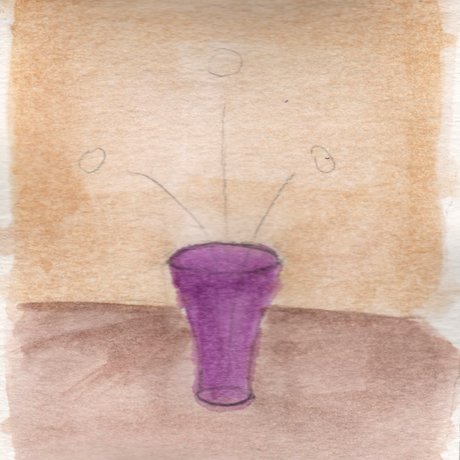 When you are sure that everything is dry, we take cobalt violet light (depending on who chooses which color) and dye the vase with a clear color, again wait for drying to continue further work.
When you are sure that everything is dry, we take cobalt violet light (depending on who chooses which color) and dye the vase with a clear color, again wait for drying to continue further work.
 We put chiaroscuro on the vase, we will do it in the same color as the vase was dyed, only the paint should be of a slightly denser consistency. We are waiting for the paint to dry.
We put chiaroscuro on the vase, we will do it in the same color as the vase was dyed, only the paint should be of a slightly denser consistency. We are waiting for the paint to dry.
 We put a shadow on the table, we will do it with the same color of paint as the table was painted, the table closer to the background (wallpaper) should be a little darker, but it should not be noticeable, paint this part of the table again.
We put a shadow on the table, we will do it with the same color of paint as the table was painted, the table closer to the background (wallpaper) should be a little darker, but it should not be noticeable, paint this part of the table again.
 When you circle the middle circles with petals, let the paint dry out, then take a thin brush and make lines like in the middle of each petal.
When you circle the middle circles with petals, let the paint dry out, then take a thin brush and make lines like in the middle of each petal.
 Let us draw the stems with dark green marsh paint to our colors.
Let us draw the stems with dark green marsh paint to our colors.
 Pure dark green paint, one number of brushes draw the leaves. When the work is dry, it will already be considered complete.
Pure dark green paint, one number of brushes draw the leaves. When the work is dry, it will already be considered complete.


